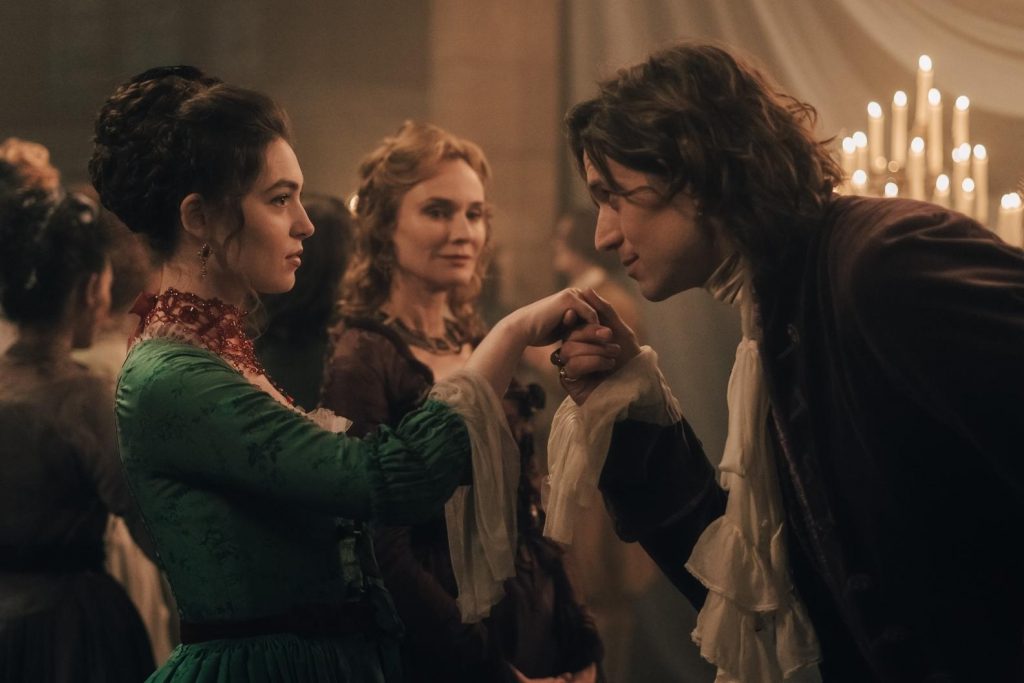To master the art of seduction, one must dress the part – just ask Pascaline Chavanne, the Costume Designer for HBO’s French original drama series, The Seduction.
Loosely adapted from the 1782 novel, Les Liaisons Dangereuses by Pierre Choderlos de Laclos, the show follows one young woman’s journey to become Paris’ leading courtesan. Director Jessica Palud told Variety that while the show was inspired by the original novel, she was keen to envision these characters through a more feminist lens, exploring more intensely themes of sexual liberation and gender politics. She also says she sought to create a world that was both firmly anchored in a period drama but that still felt modern.
To achieve that contemporary edge, Palud enlisted a cast of characters that are all younger than their literary inspirations and in fact than the cast of the 1985 film adaptation which starred Glenn Close and John Malkovich. Instead, starring in the French language drama are Diane Kruger (Inglorious Bastards) as Madame de Rosemond, Anamaria Vartolemei (Being Maria) as Marquise de Merteuil, Vincent Lacoste (A Private Life) as Vicomte de Valmont, and Lucas Bravo (Emily in Paris.)
She also drew inspiration and instruction from other period dramas that broke the mold telling Variety she was aiming for an effect that was more Barry Lyndon that Marie Antionette. Understandably, a critical part of this also came down to the show’s costuming and the collaboration between Palud and Chavanne. When it comes to period dramas, visuals in particular are a role entirely their own; they can signal everything from the status or class of a characters, to how faithful a show’s portrayal of history is to the truth. Seemingly small decisions about fabrication and design have significant implications beyond what a viewer might even realize and even the very preparation and sourcing of period costumes is a process all its own.
Along with a team that included Costume Assistant, Camille Joste who oversaw documentation and textiles, Francesca Sartori, the Head of Tailoring Workshop, and Justine Vivien, the Head of Soft Construction Workshop, she Chavanne a visual world that is as sensuous as it is lush and that much like the show’s storyline is indulgent and scandalous without ever feeling heavy handed. Forbes spoke via email with Chavanne about undertaking such a significant project, working with Palud, and more.
Caroline Reilly: What inspired you to become a costume designer?
Pascaline Chavanne: After studying scenography, which focused primarily on artistic sense and the design of theatrical space, I became passionate about costume creation. That’s when I felt the need to deepen my knowledge in the area of historical costume making.Participating in the birth of a character alongside the actor and the director is absolutely fascinating. It’s about helping the director tell a story, as clothing carries meaning.
Reilly: When you first read the script for The Seduction, what images immediately came to mind?
Chavanne: Paintings by Fragonard, Watteau, and Boucher, artists who sought to beautify women, pleasure, and sensuality; 18th-century erotic painting, but also Vigée Le Brun. And of course, Stephen Frears’ film Dangerous Liaisons, which I instantly wanted to watch again.
Reilly: The series is a loose adaptation of Les Liaisons Dangereuses—how did this original work influence your costume design?
Chavanne: The Seduction is a work of mind, but above all, of the body. For me, it was important that the costumes not be a barrier to the closeness and movement of bodies. So, rather than being stiff, the fabrics, mainly silk taffeta, had to be as light as possible to better accompany the body with fluidity.
Reilly: Tell me about your research process for designing the costumes for a period piece of this scale.
Chavanne: What mattered most to me was conveying the power of the body in this interpretation of Laclos’ work. The period cuts are respected, but I made very free choices in terms of fabric and accessories. For instance, instead of using lace for sleeve ruffles (engageantes), I used silk tulles that flutter at the ends of the sleeves.
Reilly: I’d love to hear more about your collaboration with Jessica Palud on set.
Chavanne: I was very intrigued by Jessica’s innovative approach to the material. We both strongly wanted to modernize the 18th century. Jessica is very open to suggestions. We wanted the actors to feel supported by the costumes, not constrained by them and to never have their movements hindered. In short, for them to forget the costumes, or rather, for the costumes to help them in their performance so they could naturally make them their own.
Reilly: As a costume designer, what are the biggest challenges and most rewarding parts of working on a period project?
Chavanne: Let’s say, there have been the films by Stephen Frears, Milos Forman, the painters of the 18th century, so many beautiful works that it can feel overwhelming to think you have to match or even surpass them. But in the end, every era has its codes and deserves to be revisited through a contemporary lens. It’s also very exciting to have the opportunity to work with such large and diverse teams, especially in an age of AI. For example, some of Valmont’s garments are adorned with hand-painted buttons, each with different miniatures, just like in the period. Others are embroidered. The job of a costume designer encompasses a wide range of specialties, each carried out by different individuals. It’s incredibly rich on a human level.
Reilly: Do you have any favorite moments or costumes from the season?
Chavanne: There are many different moments that I love, but I’m often moved by the grace of the actors in motion, in their costumes, especially when magnified by Sébastien Buchmann’s lighting and Florian Sanson’s sets.

